Key takeaways
- Digital fashion magazines enhance interactivity and accessibility, allowing readers to engage with content through comments and social sharing, while showcasing a diverse range of fashion topics.
- Fashion blogging helps express personal style, build a community, and open doors to industry opportunities through genuine connections with readers and collaborations with brands.
- Choosing the right platform, like WordPress, is essential for customization and user-friendliness, allowing bloggers to enhance their content and functionality effectively.
- Authenticity and engagement are key to thriving in fashion blogging, as sharing personal experiences and responding to the audience fosters a vibrant community.
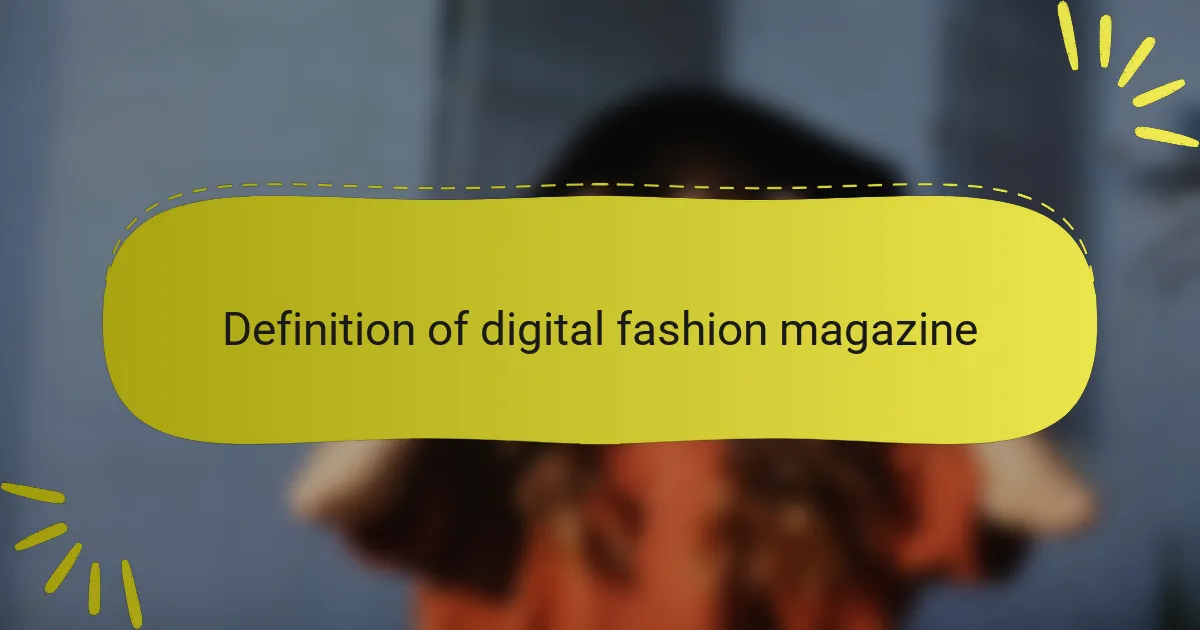
Definition of digital fashion magazine
A digital fashion magazine is an online platform that curates the latest trends, styles, and industry insights from the ever-evolving world of fashion. Unlike traditional print magazines, these digital spaces offer interactivity, allowing readers to engage with content through comments, social media shares, and more personalized experiences. I find it exhilarating when I stumble upon a digital magazine that not only showcases beautiful outfits but also shares genuine stories behind them.
Here are some key characteristics of digital fashion magazines:
- Interactivity: Readers can comment and share their thoughts instantly.
- Visual Appeal: High-quality images and videos enhance the storytelling experience.
- Timeliness: Articles are updated frequently, allowing for current trends.
- Diverse Content: Covers a range of topics from street style to high fashion.
- Accessibility: Easily accessible on various devices anytime, anywhere.
Listening to stories about how clothing affects personal expression in these magazines reminds me of my own journey in fashion blogging. I started my blog to connect with others who share my passion, and it became a fulfilling outlet that allowed me to showcase my personality through my love for style.
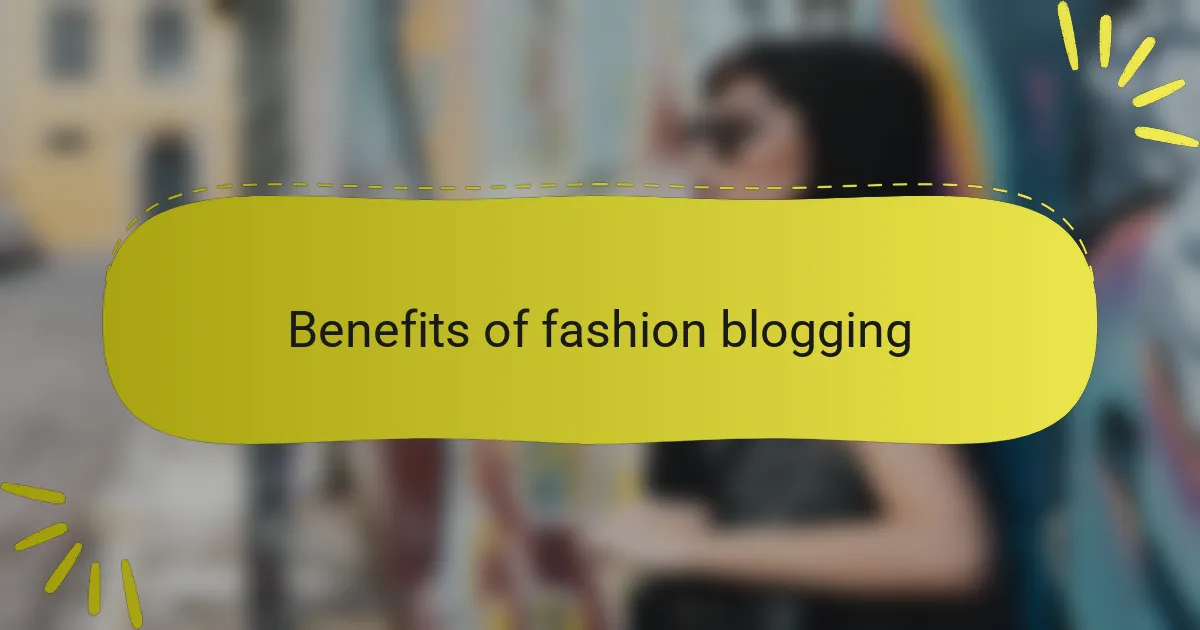
Benefits of fashion blogging
Fashion blogging offers a unique platform to express personal style and creativity. I remember when I first started, the thrill of showcasing my favorite outfits and sharing styling tips felt incredibly rewarding. Each post became a canvas where I could highlight my personality, allowing me to connect with like-minded individuals who appreciated my vision.
Another significant benefit is the opportunity to build a community. I’ve found that engaging with readers and fellow bloggers is not just about sharing content; it’s about fostering relationships. Have you ever received a comment from someone thanking you for inspiring their wardrobe choices? Those moments remind me why I started blogging in the first place.
Moreover, fashion blogging can serve as a stepping stone into the industry itself. I’ve had the chance to collaborate with brands and attend events that I never would have imagined before starting my blog. This exposure has enriched my understanding of the fashion world while expanding my network and opening doors to new opportunities. It’s truly exciting to see how each blog post can lead to something bigger!
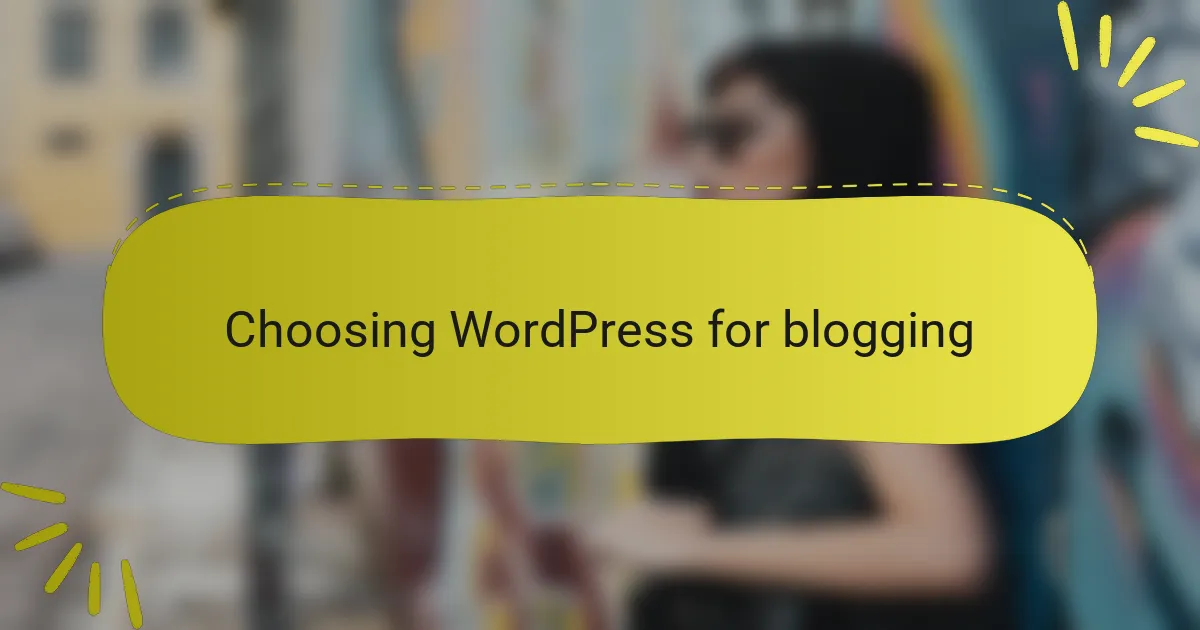
Choosing WordPress for blogging
When I first decided to dive into fashion blogging, choosing the right platform was crucial. WordPress stood out to me because of its flexibility and user-friendly interface. I still remember the excitement of customizing my first theme, which perfectly mirrored my personal style.
One of the main reasons I opted for WordPress was the vast array of plugins available. These tools made enhancing my blog’s functionality so effortless! I could easily integrate social media sharing and optimize my posts for search engines.
Here’s a quick comparison of WordPress and other popular blogging platforms based on my experience:
| Feature | WordPress | Blogger | Wix |
|---|---|---|---|
| Customization | Extensive themes and plugins | Limited options | Drag-and-drop interface |
| Ease of Use | User-friendly | Simple but basic | Intuitive but can be limiting |
| Control | Full control over content | More restrictions | Moderate control |
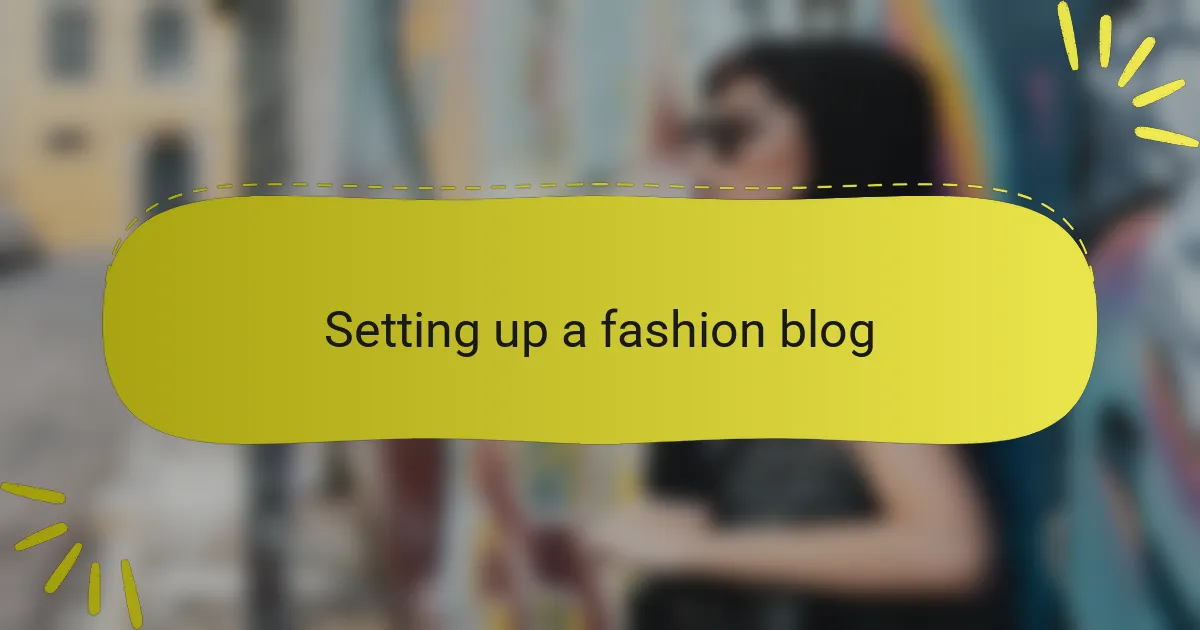
Setting up a fashion blog
Setting up a fashion blog can feel like embarking on an exciting journey. For me, the initial step was choosing the right domain name; I wanted something that reflected my unique style yet was memorable. It was a bit nerve-wracking at first—would anyone resonate with my vision? But once I found the perfect name, I felt a surge of motivation that pushed me to move forward.
The first few days were filled with trial and error as I navigated WordPress. I played with various themes, not entirely sure what would best represent my aesthetic. I still recall the moment I settled on a theme that felt just right; it was like finding the perfect outfit that instantly boosts your confidence. Personalizing layouts, colors, and fonts became a creative outlet where I could genuinely express who I was!
Don’t overlook the importance of figuring out your content strategy early on. I vividly remember setting aside time each week to brainstorm blog topics that excited me. This not only kept my creative juices flowing but helped build a consistent posting schedule, which I now see is crucial for keeping readers engaged. What strategies have you considered to maintain your blog’s momentum? Believe me, planning and engaging with your audience will make all the difference.
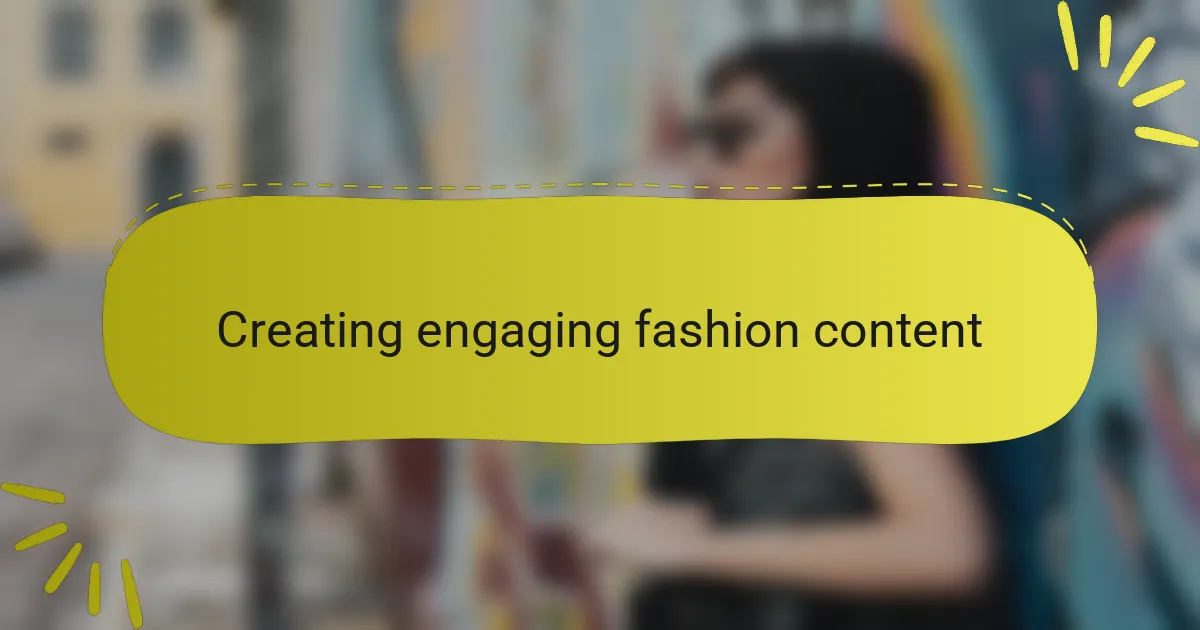
Creating engaging fashion content
Creating engaging fashion content is all about authenticity and connection. I’ve found that sharing not just the outfits but the emotions behind them resonates deeply with readers. For instance, there’s a significant difference when I describe how a specific dress made me feel on a special occasion rather than simply posting a picture. Those details bring stories to life and invite readers to see themselves in my experience.
Visual appeal plays a critical role in capturing attention. From my perspective, a striking image or a well-composed video can speak volumes. I often spend time curating visuals that complement my writing; it’s where the magic happens. Combining vibrant photos with heartfelt narratives creates an experience that keeps my audience returning for more.
Lastly, interaction is key to creating a thriving community. I remember a moment when a reader reached out to share how my style had inspired them to wear something new. Those connections encourage me to keep sharing, reminding us all that our words and styles can empower others. What’s more fulfilling than knowing your content makes a difference?
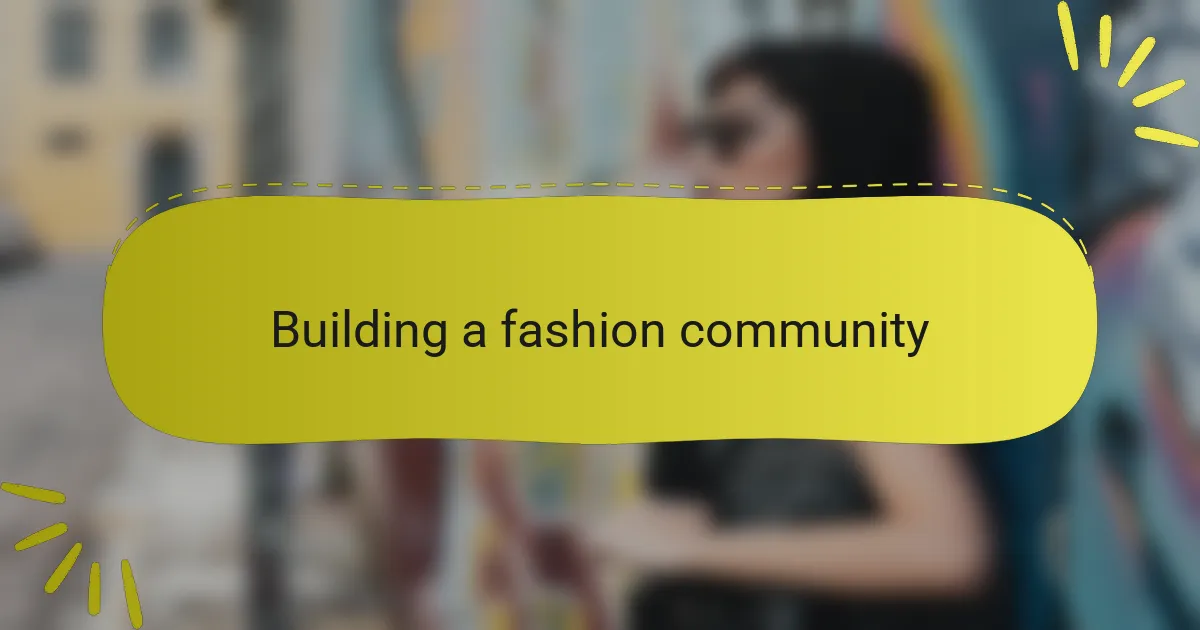
Building a fashion community
Building a fashion community starts with authentic engagement. I remember when I first began engaging with my readers—it was a game-changer. Responding to comments and sharing insights not only fostered relationships, but also made my readers feel valued. Have you ever felt that connection with a creator? Those interactions can transform a simple blog into a vibrant community.
Moreover, community-building requires consistency. I learned that regularly sharing my journey—whether it was a victory or a setback—helped create a sense of camaraderie. For example, I posted about my struggles with self-image, which resonated deeply with my audience. Sharing those experiences opened the door for readers to share their own stories. Isn’t it remarkable how vulnerability can inspire others to open up?
Lastly, collaborating with other bloggers and creators further enriches the community. I’ve had the pleasure of joining forces with fellow fashion enthusiasts for guest posts and joint social media challenges. These collaborations not only expand reach but also introduce varied perspectives that excite and inspire. Have you thought about how these partnerships could enhance your own blogging experience? It’s a beautiful way to build connections and explore new creative avenues together.

Lessons learned from my journey
Throughout my journey in fashion blogging on WordPress, I’ve learned several invaluable lessons. One key takeaway is the importance of authentic self-expression. When I first started, I tried to mimic other successful bloggers, but it wasn’t until I embraced my unique style and voice that my audience began to resonate with my content.
Another lesson was understanding the balance between aesthetics and functionality. I invested time in customizing my WordPress site, but I also had to ensure that it was user-friendly. As I navigated these challenges, I realized that creating a visually appealing site should not come at the expense of accessibility.
Finally, engaging with my audience has been crucial. Early on, I started responding to comments and incorporating feedback. This two-way communication not only strengthened my community but also provided me with fresh ideas for my posts.
| Lesson | Key Insight |
|---|---|
| Authenticity | Embrace your unique style to connect with your audience. |
| Functionality | Balance aesthetics with user experience for better engagement. |
| Engagement | Listen to your audience; their feedback is a goldmine for inspiration. |